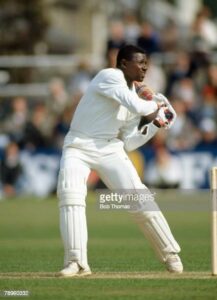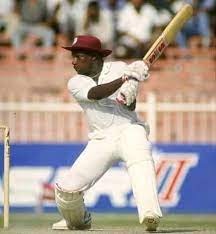By Tony McWatt
Born January 12, 1962, in the Five islands Village of his native Antigua, Richard Benjamin Richardson, now fondly known universally as Sir Richie following his February 28th 2014 Antigua government rendered appointment as a Knight Commander of the Order Of the Nation, remembers playing cricket from ever since he first knew himself! Everyone in his immediate environment was for that matter similarly engaged, playing cricket, whether it was in the yard, in the streets or on the pastures that dotted the Antigua village where he was born.
Richardson’s family house was located just next to the village’s playing field which was nearly always full of people actively playing cricket or football. Antigua’s perennial two most popular sports.
Whenever he got the chance he engaged himself in whatever form of cricket was being played. Richardson, who had always been keen on being active outdoors, however, initially enjoyed playing football more than he did cricket in his early youth.
That changed when he was around age eight or nine. His mother sent him on an errand, during which he saw many of his fellow villagers (mainly adults) listening attentively to the radio broadcast of a West Indies Test match that was being played in one of the other Caribbean islands. Antigua was at a virtual standstill with no one working or doing anything other than being glued to the few transistor radios that were available. He was also fascinated by the ardent discussions which were being held about famous West Indies players such as Gary Sobers, Wes Hall, Charlie Griffith, Rohan Kanhai and Lance Gibbs, etc.
Having been exposed to such publicly displayed adoration for such great West Indian cricketers, Richardson figured to himself that they must have been doing something really good and important for their countries and the region as a whole. His already very sharp mind also made the immediate and quantum leap into thinking that if they could maybe, someday he might also do the same.
Thus began the now Sir Richie Richardson’s mental excursion into the transformation of the world-class, all-time great, West Indies cricketer he would eventually become. He immediately started working harder at his cricket, taking it much more seriously. He also told himself that one of the ways he could improve very quickly would be to constantly play against guys who were much bigger and better than he was.
Performing at his best and “holding his own” against superior opposition, thus became a mantra and adopted modus operandi for the fledgling Richardson. At that time he was still playing mostly recreational cricket with used tennis balls or others than had been fashioned from twine, rubber or any other suitably adaptable and readily available materials. It was only after he started attending Secondary School, at around age
twelve, that he received his first introduction and exposure to hardball
cricket. The village had actually stopped playing hard ball cricket
on its playing field. Richardson’s response was to roll his own pitch
somewhere in the village.
He would get guys to come and bowl at him on his “homemade turf!”
When any such bowlers weren’t readily available he would go to the
schoolyard and convince his fellow schoolmates to bowl at him on
the concrete strip that was there, “for hours and hours and hours!”
He also used to encourage the bowlers to use plastic shell balls
which would slide off the concrete surface and onto the bat that
much quicker. This helped him to develop the rapid eye-to-hand
coordination that would become one of his most valuable assets as a
top-order batsman.
Richardson had by then become joyously enamoured with batting. It
was an inherent joy that would become so evident during his entire
outstanding career.
By his second year of Secondary School, he had already made not
only his own school’s team but he was also selected to represent
the Combined Schools in the island’s First Class Competition. That
was his first introduction to Guy Yearwood who was the Combined
Schools Team’s Coach.
It was the beginning of a long-lasting relationship that was crucial
to Richardson’s development, Yearwood, who had represented
Antigua as an opening batsman became both a mentor and coach to
Richardson. He curbed Richardson’s technique, especially against pace
and also became a major motivational force behind his protégé’s work
ethic and dedication.
Under Yearwood’s watchful coaching eye Richardson was
subsequently selected to the Antigua National team. Richardson had
always wanted to be among the very best and harboured the self-confidence
inspired desire to eventually play for the West Indies. It
was, however, Yearwood who instilled in him the actual belief that he
could indeed progress to earning subsequent selection not only to the
Antigua and Leeward Islands teams but eventually also all the way to
representing the West Indies in Test matches.
Yearwood told him that he could really make it and that as such he
should start taking his cricket very seriously. Richardson immediately
took Coach Yearwood’s provided advice to heart. He made the
commitment, dedicating and devoting himself to playing cricket to the
very best of his God-given abilities.
Richardson and Eldine Baptiste, who by that time had become his
closest cricket friend, both spent a lot of time being
coached by Yearwood. Performing all the required
daily drills to sharpen and strengthen their respective
technical skills and powers of disciplined concentration.
Not surprisingly, he performed sufficiently well at the
1980-81 National Team Trials to earn his Selection
to the Antigua team for its participation in the annual
Leeward Islands Championships.
Richardson’s Leeward Island Championships
performances earned his selection to the West
Indies Team. In fulfilment of
Guy Yearwood’s prediction, he
made his West Indies Test debut
on November 24, 1983. He debuted
appearing against India as the 180th Test
cricketer to represent the West Indies.

Richardson suffered the ignominy of being
dismissed for 0 in his very first Test appearance
at the crease. Adjudged lbw off the second ball he
faced to be one of Shivlal Yadav’s five victims in the
West Indies first innings total of 493. Richardson was
extremely shocked by the decision and the veracity of
the appeal by the players because the ball had hit the
face of his bat. He nonchalantly walked off and said to
himself, “Test cricket is going to be tough, but I will not
be deterred”.
Both standing Umpires in the Test were
Indian nationals and there were, of course, no television
replays at that time to verify the accuracy, or lack
thereof, of the rendered decision. He fared somewhat
better in the second innings, getting to 26 before he was
bowled by Ravi Shastri.
Richardson scored back-to-back centuries, 138 and 154
in the third and fourth Tests of the 1984 Caribbean
Home Series against the touring Australians. And in his
own words from that point onwards “I never looked
back!”
By the time he called quits on his Test career some
twelve years later, appearing in his 86th match and
signing off with a 93 in the final match of the 1995 Series
against England at the Oval, Richardson had scored 5949
runs for the West Indies at a very respectable average
of 44.39. Those runs were punctuated by 16 centuries
and 27 half-centuries and with a highest score of 194.
The former England seam bowler Mike Sevey’s Cricinfo’s
description of Sir Riche Richardson’s career as a West
Indies Test batsman is most apt:
“Out of the shadow of Viv emerged Richie. Richards followed by Richardson
was somehow genealogically appropriate. There was a contrast, though.
Richards was volatile and explosive in word and deed. His successor as
West Indies captain was genteel and gentle, unfailingly courteous, and
modest. He stood for sportsmanship in an age where such values were
beginning to disappear, and deserved better than the shabby underhand
power-brokering that eventually saw him dethroned. Like Richards, he also
declined to wear a helmet, and his wide-brimmed maroon sunhat became
a trademark. He was a destructively brilliant batsman, particularly on
hard pitches where he could throw the bat through the line with abandon,
carving the ball square. He hooked willingly too, usually up, frequently
for six. Criticism was usually directed at his lack of concentration, but he
was capable of that: his 69 grafted out over four hours on a vile pitch
at Edgbaston in 1995 was a masterly exhibition of bad-wicket play. He
reserved his finest innings for the Australians: only Sachin Tendulkar and
Jack Hobbs have bettered his nine centuries against them. The finest was
at Georgetown in March 1991, when he blasted 182, including 106 in the
final session of the first day!”
